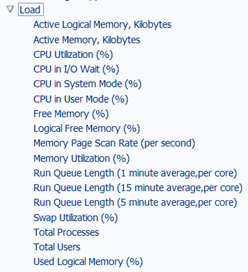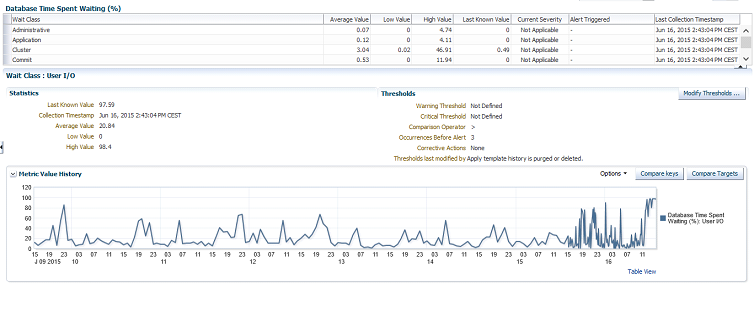The Enterprise Manager Cloud Control 12c is an amazing tool allowing the DBA to display a lot of informations from the console . But there are also a lot of repository views that may be consulted by the DBA to build a lot of various reports.
The Oracle Management Service collects a huge amount of raw data from the agents installed on each managed host you administer with EM 12c.
Those raw data are inserted in various tables like EM_METRIC_VALUES for example. Enterprise Manager aggregates those management data by hour and by day. Those raw data are kept 7 days; the one hour aggregated data are kept 31 days, while one day aggregated data are kept one year.
A good way to get information in the Oracle Management Repository is to build queries against the GC%METRIC% views. The GC_METRIC% views are built from EM_METRIC_VALUES. EM_METRIC_ITEMS and EM_METRIC_KEYS tables and the GC$METRIC% views are built from the GC_METRIC% views. There are a lot of GC%METRIC% views :
SQL> select distinct view_name from user_views where view_name like 'GC%METRIC%' order by 1;
GC$METRIC_CATEGORIES GC$METRIC_COLUMNS GC$METRIC_COLUMNS_TARGET GC$METRIC_ERROR_CURRENT GC$METRIC_ERROR_HISTORY GC$METRIC_GROUPS GC$METRIC_GROUPS_TARGET $METRIC_KEYS GC$METRIC_LATEST GC$METRIC_STR_VALUES GC$METRIC_STR_VALUES_LATEST GC$METRIC_VALUES GC$METRIC_VALUES_DAILY GC$METRIC_VALUES_HOURLY GC$METRIC_VALUES_LATEST GC$TARGET_METRIC_COLLECTIONS GC_METRIC_COLLECTIONS GC_METRIC_COLUMNS GC_METRIC_COLUMNS_TARGET GC_METRIC_COMPOSITE_KEYS GC_METRIC_GROUPS GC_METRIC_GROUPS_TARGET GC_METRIC_KEYS GC_METRIC_LATEST GC_METRIC_LATEST_WO_TGT GC_METRIC_STATS_METRIC GC_METRIC_STATS_METRIC_DAILY GC_METRIC_STATS_TARGET GC_METRIC_STATS_TARGET_DAILY GC_METRIC_STR_VALUES GC_METRIC_STR_VALUES_LATEST GC_METRIC_STR_VALUES_WO_TGT GC_METRIC_THRESHOLDS GC_METRIC_VALUES GC_METRIC_VALUES_DAILY GC_METRIC_VALUES_HOURLY GC_METRIC_VALUES_LATEST GC_METRIC_VAL_HOURLY_WO_TGT GC_RAT_TRIAL_METRIC_VALUES GC_RAT_TRIAL_TARGET_METRICS
For example if we are interested by the load for a host, you can use the console:

You can also find this information by querying the OMR in the view gc$metric_columns for an entity of type host and a metric_group_label of type Load:
SQL> select entity_type,metric_column_label,metric_group_label from gc$metric_columns where entity_type = 'host' and metric_group_label = 'Load';
host Active Logical Memory, Kilobytes Load host Active Memory, Kilobytes Load host CPU Interrupt Time (%) Load host CPU Queue Length Load host CPU Utilization (%) Load host CPU in I/O Wait (%) Load host CPU in System Mode (%) Load host CPU in User Mode (%) Load host Free Memory (%) Load host Free Memory, Kilobytes Load host Logical Free Memory (%) Load host Memory Page Scan Rate (per second) Load host Memory Utilization (%) Load host Page Transfers Rate Load host Run Queue Length (1 minute average,per core) Load host Run Queue Length (15 minute average,per core) Load host Run Queue Length (5 minute average,per core) Load host Swap Free (KB) Load host Swap Utilization (%) Load host Swap Utilization, Kilobytes Load host Total Processes Load host Total Users Load
We can sort the metrics collected by entity type for example host :
SQL> select entity_type,metric_group_label from gc$metric_columns where entity_type = 'host' group by entity_type,metric_group_label order by 1,2;
host All Processes host Battery details host Buffer Activity host CCCAppFileParser host CCCData_base host CCCData_group host CCCData_mapping host CCCData_obs host CCCData_queue host CCCData_warning host CCCWatchdog host CPU Usage host CPU Usage Internal host CPUs Details host Compute Node Temperature host DiscoverNow …. Or an oracle database:
SQL> select entity_type,metric_group_label from gc$metric_columns where entity_type = 'oracle_database' group by entity_type,metric_group_label order by 1,2; oracle_database ADDM Report - Global oracle_database ALL Privileges oracle_database ANY Privileges oracle_database Access To Important Tables And Views oracle_database Active Sessions by CPU and Wait Classes oracle_database Alert Log oracle_database Alert Log Content oracle_database Alert Log Error Status oracle_database Archive Area oracle_database Archive Area - RAC Instance oracle_database Audit Settings oracle_database Audit Syslog Level oracle_database AutoTask Client oracle_database CPU Usage oracle_database Collect SQL Response Time oracle_database Connect Role oracle_database Control files oracle_database DB Alert Log oracle_database DB Audit Files Permissions oracle_database DB Control Files Permission oracle_database DB Data Files Permissions oracle_database DB InitParameter File Permissions oracle_database DB Link Usage oracle_database DB Password Setting oracle_database DB Profile Setting oracle_database DB Scheduler Jobs oracle_database DBA Group Assignment oracle_database DGPrimaryDBName oracle_database Data Base parameter collection oracle_database Data Failure oracle_database Data Guard - 10.1 Database oracle_database Data Guard - 9.2 Database oracle_database Data Guard Failover oracle_database Data Guard Fast-Start Failover oracle_database Data Guard Fast-Start Failover Observer
So the main interest is to collect data from those views, for example we can look more precisely in the CPU consumption for a host:
SQL> select entity_name ,collection_time,min_value as min,avg_value as avg,max_value as max from gc$metric_values_daily where metric_group_name = 'Load' and metric_column_name = 'cpuUtil' and (entity_name like '%dbserver1%' ) order by 2,1 asc;
Entity_name collection_time min avg max dbserver1.localdomain 01-JUN-15 3.782 17.4089931 72.284 dbserver1.localdomain 02-JUN-15 2.788 11.3085764 38.61 dbserver1.localdomain 03-JUN-15 4.16 11.7149271 28.975 dbserver1.localdomain 04-JUN-15 5.526 11.6824271 29.451 dbserver1.localdomain 05-JUN-1 5.337 10.9915486 27.319 dbserver1.localdomain 06-JUN-15 5.664 16.7499653 45.798 dbserver1.localdomain 07-JUN-15 5.021 15.4098958 84.75 dbserver1.localdomain 08-JUN-15 4.664 9.7744375 28.159 dbserver1.localdomain 09-JUN-15 4.79 9.4026805 21.113 dbserver1.localdomain 10-JUN-15 5.17 9.5937881 31.238 dbserver1.localdomain 11-JUN-15 5.162 8.8185104 16.562 dbserver1.localdomain 12-JUN-15 5.666 11.0074132 33.058 dbserver1.localdomain 13-JUN-15 6.412 15.4432917 42.709 dbserver1.localdomain 14-JUN-15 5.897 9.6474548 40.575 dbserver1.localdomain 15-JUN-15 5.675 14.5982083 34.483
For a more precise measure you can select on gc$metric_values_hourly:
SQL> select entity_name,collection_time,min_value as min,avg_value as avg,max_value as max from gc$metric_values_hourly where metric_group_name = 'Load' and metric_column_name = 'cpuUtil' and (entity_name like 'dbserver1%' ) order by 1,2 /
Entity_name collection_time min avg max …. dbserver1.localdomain 15-JUN-15 14:00:00 15.23 18.65 22.025 dbserver1.localdomain 15-JUN-15 15:00:00 7.844 9.17 11.406 dbserver1.localdomain 15-JUN-15 16:00:00 8.635 10.76 13.625 dbserver1.localdomain 15-JUN-15 17:00:00 7.928 9.57 16.607 dbserver1.localdomain 15-JUN-15 18:00:00 8.439 13.39 21.518 dbserver1.localdomain 15-JUN-15 19:00:00 7.722 10.56 14.767 dbserver1.localdomain 15-JUN-15 20:00:00 7.993 9.09 12.934 dbserver1.localdomain 15-JUN-15 21:00:00 7.449 9.20 12.2 dbserver1.localdomain 15-JUN-15 22:00:00 8.001 10.47 16.328 dbserver1.localdomain 15-JUN-15 23:00:00 7.366 8.77 14.51 ….
We can also display those values in the EM12c console:

Thus there are great possibilities to query the gc$metric_values% views in order to build reports. For example if we look at the different metric_group_label for an oracle database entity:
SQL> select distinct metric_group_label from gc$metric_values_daily 2 where entity_type = 'oracle_database' order by 1;
Alert Log Error Status Archive Area CPU Usage Database Job Status Database Limits Database Size Deferred Transactions Dump Area Efficiency Flash Recovery Global Cache Statistics Interconnect Traffic Invalid Objects by Schema Memory Usage Messages per buffered queue Messages per buffered queue per subscriber Messages per persistent queue Messages per persistent queue per subscriber OCM Instrumentation Optimal SGA PGA Allocated Recovery Area Response SCN Growth Statistics SCN Instance Statistics SCN Max Statistics SGA Pool Wastage Segment Advisor Recommendations Space usage by buffered queues System Response Time Per Call Tablespace Allocation Tablespaces Full Throughput User Audit User Block User Locks Wait Bottlenecks Waits by Wait Class backup_archive_log_age datafile_backup flashback available incident_meter max number of datafiles
Then we can ask for more precise measures:
SQL> select distinct key_part_1 from gc$metric_values_daily where metric_group_name = 'wait_sess_cls' order by 1;
Administrative Application Cluster Commit Concurrency Configuration Idle Network Other Queueing Scheduler System I/O User I/O
And we can write a SQL request to analyse the User I/O wait:
SQL> select collection_time, min_value as min_wait , avg_value as avg_wait , max_value as max_wait from gc$metric_values_daily where metric_group_name = 'wait_sess_cls' and metric_column_name = 'dbtime_waitclass_pct' and (entity_name like 'dbserver1%' ) and key_part_1 = 'User I/O' order by 1,2 asc;
Collection_time min_wait avg_wait max_wait 01-JUN-15 .190094016 45.7777238 86.9431254 02-JUN-15 .026723742 49.4623178 98.6886502 03-JUN-15 .09020789 32.6063701 98.7430495 04-JUN-15 .066328202 26.342438 97.1319971 05-JUN-15 .032959651 22.7424382 96.1533236 06-JUN-15 .574570414 22.2140084 93.9315499 07-JUN-15 .022970399 20.6773665 88.9020253 08-JUN-15 .058117038 17.5328715 98.5629756 09-JUN-15 .080441214 20.5507072 98.4615166 10-JUN-15 .057529812 19.1080933 97.4292408 11-JUN-15 .038726475 21.6932703 96.48269 12-JUN-15 .106343267 25.0541945 89.5404451 13-JUN-15 .257816863 13.5371153 80.1841142 14-JUN-15 .004258955 16.5949771 84.7824337 15-JUN-15 .020058791 19.1270265 89.8952919
Naturally we find back those I/O values in the EM12c console:

Conclusion: querying the OMR views might allow Oracle DBA to build interesting reports on Hosts and Databases activities.
![Thumbnail [60x60]](https://www.dbi-services.com/blog/wp-content/uploads/2022/12/oracle-square.png)
![Thumbnail [90x90]](https://www.dbi-services.com/blog/wp-content/uploads/2022/08/DWE_web-min-scaled.jpg)